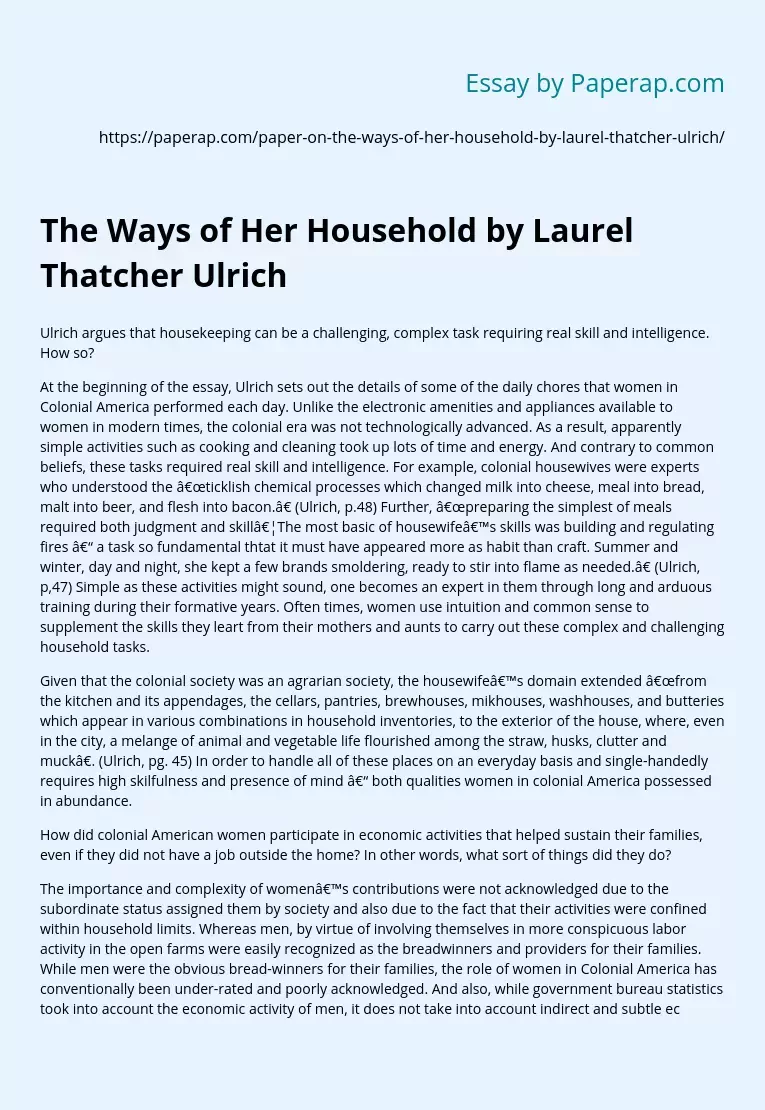The following sample essay on The Ways of Her Household by Laurel Thatcher Ulrich. Ulrich argues that housekeeping can be a challenging, complex task requiring real skill and intelligence. How so? At the beginning of the essay, Ulrich sets out the details of some of the daily chores that women in Colonial America performed each day. Unlike the electronic amenities and appliances available to women in modern times, the colonial era was not technologically advanced. As a result, apparently simple activities such as cooking and cleaning took up lots of time and energy.
And contrary to common beliefs, these tasks required real skill and intelligence. For example, colonial housewives were experts who understood the “ticklish chemical processes which changed milk into cheese, meal into bread, malt into beer, and flesh into bacon.”
Further, “preparing the simplest of meals required both judgment and skill… The most basic of housewife’s skills was building and regulating fires – a task so fundamental thtat it must have appeared more as habit than craft.
Summer and winter, day and night, she kept a few brands smoldering, ready to stir into flame as needed.” Simple as these activities might sound, one becomes an expert in them through long and arduous training during their formative years. Often times, women use intuition and common sense to supplement the skills they leart from their mothers and aunts to carry out these complex and challenging household tasks. Given that the colonial society was an agrarian society, the housewife’s domain extended “from the kitchen and its appendages, the cellars, pantries, brewhouses, mikhouses, washhouses, and butteries which appear in various combinations in household inventories, to the exterior of the house, where, even in the city, a melange of animal and vegetable life flourished among the straw, husks, clutter and muck”.
In order to handle all of these places on an everyday basis and single-handedly requires high skilfulness and presence of mind – both qualities women in colonial America possessed in abundance. How did colonial American women participate in economic activities that helped sustain their families, even if they did not have a job outside the home? In other words, what sort of things did they do? The importance and complexity of women’s contributions were not acknowledged due to the subordinate status assigned them by society and also due to the fact that their activities were confined within household limits. Whereas men, by virtue of involving themselves in more conspicuous labor activity in the open farms were easily recognized as the breadwinners and providers for their families. While men were the obvious bread-winners for their families, the role of women in Colonial America has conventionally been under-rated and poorly acknowledged.
And also, while government bureau statistics took into account the economic activity of men, it does not take into account indirect and subtle economic contributions made by women. But a glimpse into the latter’s daily routines gives an idea about the economic worth of household work. For example, preparing breakfast and lunch for the entire family is a productive economic contribution, in that it aids and enables the men of the family to go out to their farms and work. After early morning milking, the choice for breakfast “featured prepared foods or leftovers – toasted bread, cheese, and perhaps meat and turnips kept from the day before, any of this washed down with cider or beer in winter, with milk in summer. Only on special occassions would there be pie or doughnuts.”
Also, the lady of the household carded wool or kneaded bread in other women’s kitchens. Other household activities would include washing and ironing of clothes, sewing shirts, pants, gowns and other garments for their husbands and children. In households with young, growing children, women would have an endless task of mending, altering and knitting clothes. As England was a naval empire at the time, many colonials were seafearers. During their long absenses from home, itis the lady of the house who would take charge of the shop owned by their husbands. In the case of Hannah Grafton, she managed a retain store offering “door locks, nails, hammers, gimlets, and other hardware as well as English cloth, pins, needles and thread”. But it is important to remember that “the lives of early American housewives were distinguished less by the tasks they performed than by forms of social organization which linked economic responsibilities to family responsibilities and which tied each woman’s household to the larger world of her village or town.”
How did those economic activities vary between rural and urban women, and middleclass and poor women? By comparing the lifestyles and household inventories of women such as Beatrice Plummer, Hannah Grafton and Magdalen Wear, we can come to understand the economic contributions made by women from different socio-economic backgrounds. While Plummer lived inthe frontier, Grafton lived in a farm; Wear though lived in an urban environment. In Colonial America, while the society was segregated into the propertied and unpropertied classes and disparities of wealth existed between the two divisions, the role of women was quite similar across the board. Beatrice Plummer’s marriage to land-owning farmer Francis Plummer (whose estate was worth 343 pounds) did not relieve her of everyday household duties.
Similarly, Hannah Grafton, despite having married a mariner Joshua Grafton (whose estate was worth pounds and who had connections with the ruling elite of New England, lived and raised a famly in a modest house. Magdalen Wear was the poorer of the three whose husband’s estate hardly added up to 90 pounds in value. The fact that Wear lived in a single-story cottage with an additional loft for extra space shows the level of relative poverty suffered by her. These three ladies might represent housewives from different economic classes. But a close inspection of their household responsibilities shows how their household duties and responsibilites were largely common and how much they contribute economically.
The Ways of Her Household by Laurel Thatcher Ulrich. (2019, Feb 18). Retrieved from https://paperap.com/paper-on-the-ways-of-her-household-by-laurel-thatcher-ulrich/

